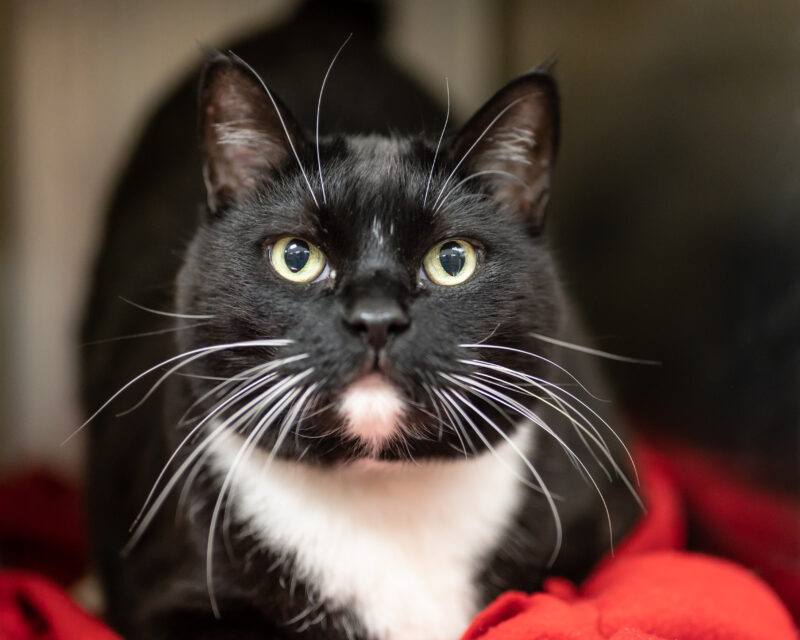
House soiling is one of the main reasons cats are surrendered to HSPPR. We know this can be stressful for both you and your cat, and we’re here to help!
The cause of litter box problems generally falls into two categories: medical or behavioral. Taking your cat to the vet when they first start having issues using the litterbox is essential to rule out any medical concerns. If it’s not medical, it’s likely behavioral, meaning your cat is probably stressed about something. Cats are creatures of habit and depend on us to keep their environment stable. Some cats are unusually sensitive to their surroundings, so you need to identify what might be causing their stress.
Possible Stressors:
- Changes in the household like a new baby or roommate, death of a caregiver, family vacation, or holidays
- Moving to a new home, remodeling the house, moving furniture, construction, or new pets in the home
- Making your outdoor cat live strictly indoors
- Traumatic or adverse experiences earlier in life
- Nervous/shy cats with increased vulnerability to provocative environments
- Weather and seasonal changes
- Traveling and trips to the vet
- Health conditions that contribute to behavioral problems
Pandora Syndrome and MEMO:
Pandora Syndrome is based on decades of research on cats with chronic urinary tract illnesses (bloody urine, frequent/abnormal urination, house soiling). It is a pathologic condition resulting from chronic activation of the central stress response system. Research has revealed that stress may be a contributing factor to feline urinary problems.
Cats vulnerable to developing urinary issues can be affected when exposed to chronic stressors throughout their life. The symptoms can involve a combination of different organ systems (skin, gastrointestinal, lung, behavioral, endocrine, urinary). They can also come and go after being triggered by a stressful event.
These threats and stressors can be alleviated by effective MEMO (Multimodal Environmental Modification). The components of MEMO are space, food, litter box, play, and conflict. Essentially, you want to provide an enriched environment, interactive play sessions, and spend more time with affected cats.
Implementing MEMO:
- Keep a consistent routine.
- Create a safe space for the cat to sleep where they can escape other pets and humans in the household. Pay attention to their preference for either low hiding spaces or vertical spaces (is your cat a tree-dweller or a bush-dweller?).
- Create a safe space to eat. Recognize their wet or dry food preference and natural cat feeding behavior of stalking and pouncing. Consider using food puzzles to engage their brain.
- Use external factors to minimize stress. Set the cat up in an area with natural light, low noise levels, and a warm temperature (85° to 100° F). Play soft music to help calm them (classical is an excellent choice).
- Play with your cat! Provide various toys that interest them and engage in interactive play multiple times per day. Some cats prefer to chase birds, while others prefer ground dwellers like bugs and mice, so you need to find the toy that most interests your cat. Keep in mind that some cats prefer social interactions such as petting and grooming over play sessions.
- Identify conflict. When cats feel threatened, they respond by attempting to restore control which can result in aggression, withdrawal, or illness.
- Follow the below litterbox tips!
Litter Box Tips:
- Spaying or neutering will help eliminate the need for marking.
- Follow the 1+1 rule: one box for each cat in the home, plus one more.
- Select litter boxes that are large enough to fit the cat’s entire body inside and allow them to turn around comfortably.
- Scoop the box daily and clean it out entirely at least once per month using a mild detergent (not bleach).
- Find a litter your cat likes. Fine-grain, soft, scoopable litter is generally preferred. Some cats may even like using a puppy pad!
- Most cats would rather have open litter boxes than enclosed litter boxes.
- The placement of litter boxes really matters. They shouldn’t be too close together, next to where they eat, or near loud noises (like washing machines and water heaters). Give them options and make the boxes easily accessible.
- Some cats may prefer one litter box for urine and a different one for defecation.
- Reward the behavior you want! Give treats and praise immediately after your cat uses the litter box.
- Senior cats may need a night light so they can more easily find the box.








